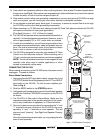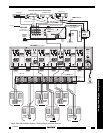
®
10
NOTE: Only
one speaker
is connected per amplifier pair in the BRIDGED mode!
CAUTION: When operating in the BRIDGED mode (particularly when bench testing the amplifier) do
not make a ground or any other kind of connection to the amplifier speaker terminals other than those
to the individual speakers as shown. Failures caused by inappropriate connections are not covered
under the warranty.
TYPICAL APPLICATIONS
Since the PA1235 has an IR control system for each amplifier pair, it can be configured so that each
individual room, in a multi-room system, can have Line Level Volume, Mute, Balance, and Standby ON/OFF
action via IR or Smart Pad control. This eliminates the need for speaker level volume controls and their
attendant power losses and reduced sound quality.
A Basic Common IR Bus System - Dedicated Keypads and Remotes.
A typical system using a low cost approach is shown in Fig. 8. It does require that a dedicated remote be
used in each room that has an IR receiver - that is, remote commands for Volume, etc., are specific for each
room.
The system is configured as follows:
1. An RS41AV is used as a low cost 4-source selector, an ideal solution when only a few sources are
desired.
2. Both IR receivers and keypads are used for system control from designated rooms.
3. A CB18 is used as a convenient parallel connecting block for the common +12 VDC, IR signal and GND
bus wiring for all the home-runs from the keypads and IR receivers in the remote rooms.
4. The Common IR is taken from the #6 connector on the CB18 (connection to any of the other connectors
would also work) & run to the Common IR IN on the PA1235 with a 2-conductor lead. Refer to Fig. 8.
5. To provide common IR control to the RS41AV and the Source Components and to power the keypads
and IR receivers, three leads are connected between the CB18 and a 789-44 Connecting Block.
6. Since a common IR bus is used to keep costs low, each of the amplifier pairs on the PA1235 must be
set to
a different IR Code Group number
, so that Volume, Mute, Balance and Standby ON/OFF in
each room can be adjusted independent of the others.
To make Code Group changes, refer to the RC68+ Programmer Instructions.
NOTE:
When shipped from the factory, all amplifier pairs of the PA1235 are set to Code Group
number A0. You may, for example, leave the #1 amplifier pair at A0 and change the other five
to B0, C0, D0, etc. Just be sure not to use a group number that is used by any other Xantech
product connected on the same IR bus (e.g. #20 used on the RS41AV).
CAUTION:
When changing the group numbers, you must connect an IR receiver to each
amplifier pair's IR input (item 11, Fig. 3) one at a time. You cannot use the Common IR Input
(item 15, Fig. 3) as this will change them all to a different, but same number.
7. After the Code Groups are set up, "teach" volume and other commands from the RC68+ Programmer
(Fig. 4) into learning remote controls (and the keypads) dedicated to each room. Be sure to set the
RC68+ to the specific Code Group Number that corresponds to the ones chosen for each of the
amplifier pairs, during this "teaching" process.
NOTE:
With a Common IR Bus system, you cannot carry the same remote control from room-
to-room. You must use a dedicated learning remote (such as the Xantech URC versions) for each
room into which you have "taught" the specific RC68+ Code Group that operates the specific
PA1235 Amplifier Pair that controls the volume, etc., for that room!
If you wish to carry remotes that have the same codes from room-to-room, use a Dedicated IR System
as shown in Fig. 10.
PA1235


















